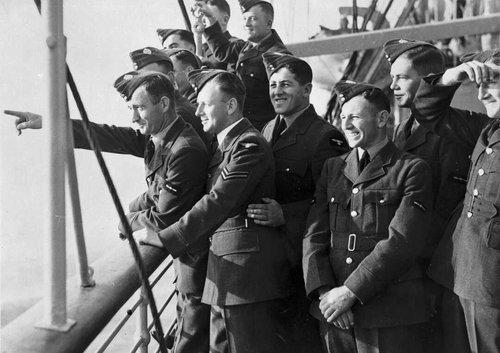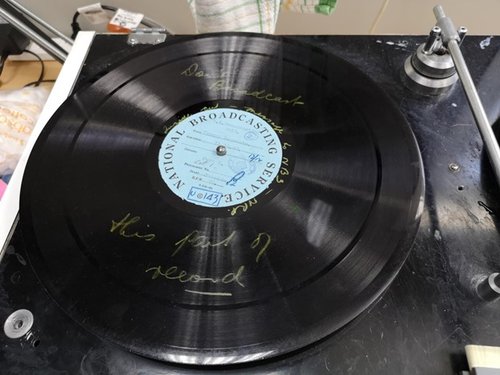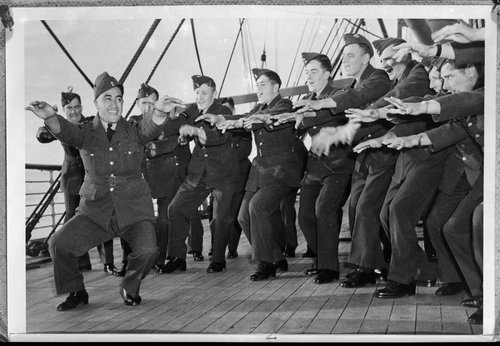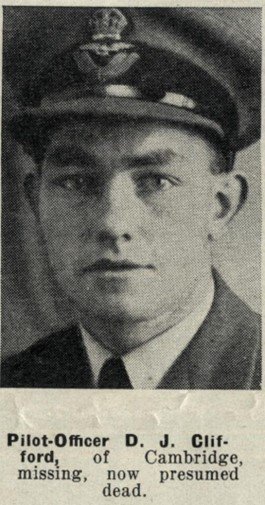
Hero image: Unidentified members of the Royal New Zealand Air Force arriving in Vancouver, Canada, for training in the Empire Air Training Scheme, 27 November, 1940. Alexander Turnbull Library, DA-00658-F
Earlier this year, in my ongoing research into sound discs recorded during World War II by New Zealand broadcasters who travelled overseas with our forces, I came across a recording which didn’t really belong. Over several months I unpicked the story of the disc. Ultimately, this gave me the great privilege of reconnecting a New Zealand airman’s wartime message home with his family, who had never heard the recording.
The 12-inch sound disc raised questions when I first came across it. One side holds a recording made in Egypt in May 1941, by the Mobile Unit broadcasters. It is part of a talk by a New Zealand nurse about her experiences in Greece and Crete. The mysterious part is the reverse side, which holds a recording named in the original RNZ Sound Archives catalogue as “Greetings from New Zealand troops in Canada.”
The Canadian recording is an anomaly in the Broadcasting Unit collection that I am researching. By rights it doesn’t belong, as it was not created by the New Zealand Mobile Unit broadcasters. Nor was it recorded in one of the theatres of war in which they operated. How did messages from men in Canada end up sharing a disc with a talk recorded in Egypt?
The answer is most likely that it found its way into this collection by default, because the disc was sent to Egypt, where the blank side of it was used by the Broadcasting Unit in May 1941. If this is the original disc, it is an extremely well-travelled object that made its way from Canada to New Zealand, to Egypt and then back to New Zealand – quite a feat in the 1940s, let alone during wartime restrictions on air and shipping. But why was a half-used disc sent across the world?
The 12-inch discs on which the Broadcasting Unit recorded had a core of aluminium, a scarce commodity in high demand worldwide during the war for use in aviation. This was coated with cellulose nitrate lacquer into which sound grooves were etched. The broadcasters in Egypt were constantly running low on discs and in their files at Archives New Zealand I have found frequent letters and telegrams to the head office in Wellington, asking for more supplies to be sent.
This aluminium core is also the reason why the 1,600 discs which survive today in the RNZ Sound Archives, held by Ngā Taonga Sound & Vision, may represent less than half the wartime Broadcasting Units’ original output. Research has established that owing to the wartime disc shortage, after their contents went to air in New Zealand, many discs were sent by the National Broadcasting Service (NBS) across the Tasman to Sydney, so that Amalgamated Wireless Australasia could re-coat them with more lacquer for re-use. Correspondence shows at least several thousand discs were recycled in this way, sadly meaning their original recordings were lost forever. (1)

Photo by Sandy Ditchburn, Ngā Taonga Sound & Vision
Another wartime broadcasting unit disc showing playback instructions written on it in chinagraph pencil.
The disc shortage is therefore probably why the NBS sent the disc from New Zealand to the Egypt-based unit, even though it was already recorded on one side. Presumably that was better than nothing and the blank side could still be recorded on and sent back to New Zealand.
The side with the Canadian recording was marked “Defective” in waxy, yellow, chinagraph pencil – a technique used by recording engineers to leave instructions for broadcasters. The recording is an incomplete series of messages home from New Zealand men who were training to serve with the Royal Air Force in Ontario, Canada. They were there as part of the Empire Air Training Scheme or EATS, which was renamed in 1942 as the British Commonwealth Air Training Plan or BCATP.
This scheme was initially established by the Royal Air Force in 1939, as Canada could provide more open air space for training the huge numbers of aircrew Britain was going to require in the war. Over 8,000 New Zealanders received air training in Canada during the war before being posted across the Atlantic to British air bases, yet today, most New Zealanders are unaware of the scheme. Anyone wanting to know more about this remarkable story should read In the Heavens Above, a lifetime project by researchers Ivan and Lorna Lindsey to ensure the role played by BCATP trainees in winning the war is not forgotten.
Messages home from Canada, like the many thousands of messages recorded by New Zealand broadcasters of Kiwis serving in the Middle East, North Africa, Italy and the Pacific, were all sent to NBS head office in Wellington, where the discs were played as part of a programme called With the Boys Overseas, which broadcast on Sunday mornings throughout the war on stations nationwide. I explored the popularity of this programme in an article for the New Zealand Journal of Public History last year.
Wartime co-operation between the Canadian Broadcasting Corporation (CBC) and the NBS facilitated the recording of messages by the air crew trainees, so it seems most likely that the ‘defective’ recording was made by the CBC. (2) Listening to the recording, we can hear each speaker is encouraged to the microphone by a professional-sounding announcer with a Canadian accent.
The Canadian side of the disc has no label at all, so I could only establish the names of the speakers by listening closely and then researching the names in Auckland War Memorial Museum’s invaluable Online Cenotaph database. This is a process I go through with all the discs I listen to, to verify the identity of each speaker. I supply Ngā Taonga Sound & Vision with the verified names for their records and I send Online Cenotaph links to each recording to add to their database.
The six airmen heard on the Canadian side are John Jasper of New Plymouth, Dan Clifford of Helensville, Jack Goodlet, from Dunedin, Bert Hibell of Palmerston North, Ken Wright of Roxburgh, and finally a few words are heard from Harold Holtom of Paekākāriki, before the recording cuts out partway through his greeting.

Alexander Turnbull Library DA-00667-F
New Zealand airmen, led by Pine Takarangi, rehearse shipboard haka on arrival at Vancouver for training in the Empire Air Training Scheme. Taken in November 1940 by an official photographer.
All six men sailed for Canada on the same troopship, the Aorangi, in December 1940. They trained together as air observers/navigators for bomber crews, firstly at No. 4 Air Observer School in London, Ontario. They graduated from No. 4 A.O. School in April 1941, so it seems likely that they were recorded at the CBC-affiliated radio station in London, Ontario in early 1941, not long after they arrived in Canada. Their recording would then have taken several weeks to get to New Zealand and then several more weeks for the disc to be packaged up by the NBS in Wellington and sent with other blank discs to the unit in Egypt.
Tragically, Online Cenotaph records also reveal three of the six young men – John Jasper, Bert Hibbell and Dan Clifford – would lose their lives the following year in operations with R.A.F. Bomber Command from various bases in England. This sad outcome was in keeping with Bomber Command’s extremely high casualty rate of 51%. (3)
Daniel Clifford grew up in Helensville, north of Auckland, and was working as a clerk for New Zealand Railways when he applied for aircrew training shortly after the outbreak of the war in October 1939. For the next year he trained in Levin, New Plymouth and Ohakea, and he married his fiancée Jean Wemyss shortly before he left for Canada in December 1940. Jean was pregnant with their daughter when he sailed. After navigation and air observer training in several locations in Canada, Daniel was commissioned as a Pilot Officer and moved to Britain, where he was finally posted to No. 142 Squadron based in Binbrook, Lincolnshire in July 1941. A month later, his baby daughter Margaret was born on the other side of the world.
No. 142 Squadron was running night bombing raids over Germany and Daniel served as an air observer on a Vickers Wellington aircraft, one of the mainstays of Bomber Command. In January 1942 while on a mission to Bremen, the bomber on which Daniel was serving was lost over the North Sea. His body was never recovered, and he would never meet his baby daughter Margaret. He was just 23 years old.
He is remembered in Britain on the Commonwealth War Graves Commission’s Runnymede Memorial for the over 20,000 Air Forces dead of World War II who have no known grave.

Courtesy Auckland War Memorial Museum Online Cenotaph
Pilot Officer Daniel Joseph Clifford, NZ401753. Killed in action 18 January 1942.
Back in Aotearoa, Daniel Clifford is remembered on the marble walls of the Hall of Memories at Auckland War Memorial Museum and in its Online Cenotaph database. In 2016, Margaret’s own daughter Rochelle Cook contributed to the Online Cenotaph page for Daniel, the grandfather she never knew.
Fortunately, she left an email contact and through this I was able to get in touch and tell her that I had found a recording by a Daniel Clifford. Could this be her grandfather? I sent her an MP3 file of the message to verify and Rochelle was able to play her 81-year-old mother Margaret the greeting recorded in an Ontario radio studio a few months before she was born. Margaret recognised the placenames that Daniel names in his greeting, as locations that were home to family members and friends – and was able to hear her long-lost father’s voice for the very first time.
It is unclear if this disc of greetings from Canada were ever played on-air in New Zealand during the war. Certainly, the Clifford family had never heard it before. The fact that this recording was labelled ‘defective’ may mean it was never aired because of its incomplete content, although the complete greetings on it could still have been edited into an episode of the With the Boys Overseas.
Daniel’s wife Jean had been able to send him a photograph of his new baby daughter Margaret in late 1941 and the family knew he received it before he was killed, which Rochelle told me gave the family some comfort. After Daniel’s death, Jean eventually remarried and had two more children. Rochelle said hearing Dan’s voice for the first time was a very moving experience and it had a deep impact on Margaret as well as the wider whānau.
Reconnecting families with the voices of departed loved ones is an incredible privilege and, in this case, a very moving one. Thank you to Rochelle Cook and her family for sharing Daniel’s story with me. Ngā mihi nui, moe mai rā e Dan.
Elements of this blog first appeared as an article in the Australasian Sound Archive journal no. 46, 2024.
References:
(1) ‘2,000 used discs sent to AWA, Sydney for resurfacing’ NBS Chief Engineer J. Smith to Noel Palmer, 8 July 1942, R22011495, Archives New Zealand, Wellington
(2) Hall, J.H. (1980) The History of Broadcasting in New Zealand, 1920-1954, Broadcasting Corporation of New Zealand, Wellington. p.130.
(3) Life and death in Bomber Command, Imperial War Museum website [Accessed 14 September 2024]